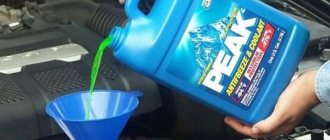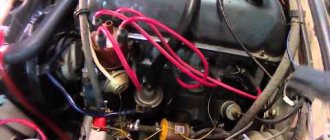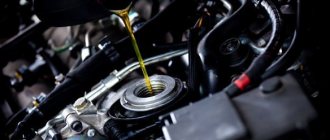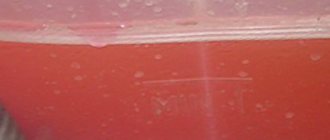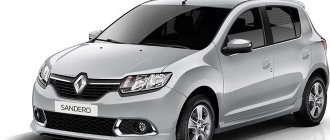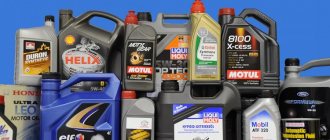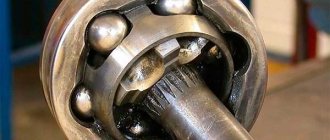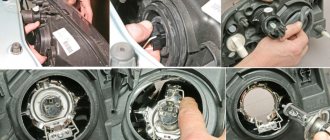The use of a liquid cooling system in cars makes it possible to maintain the engine temperature within certain limits in order to provide the most optimal conditions for the processes occurring inside the power plant.
But this system structurally complicates the engine design; in addition, it requires the presence of another engine working fluid - coolant. In this case, the liquid must circulate to remove heat from the hottest engine elements to ensure that the temperature is maintained within the specified limits. And since the cooling system is closed, the liquid must transfer the heat removed further, in the case of a car, to the environment, so that it can again pick up some of the heat. Essentially, the liquid in the cooling system is just a “transporter” of heat, but it is more efficient than the air that cools an air-cooled engine.
Why doesn't water work?
Initially, ordinary water was used as a cooling liquid for the power plant. It performed its functions quite effectively, but due to a number of negative qualities, it was practically abandoned.
The first and one of the most unfavorable factors of water as a cooling liquid is its low freezing threshold. Already at 0°C, water begins to crystallize. As the temperature decreases, water turns into a solid state - ice, and the transition is accompanied by an expansion of volume. As a result, frozen water in the cylinder block can rupture the cooling jacket, damage pipelines and destroy radiator tubes.
The second negative factor of water is its ability to deposit scale inside the cooling system, which reduces heat transfer and reduces cooling efficiency. In addition, water can react with the metal, which can cause corrosion to appear at the point of contact.
Cylinder block corrosion
Another significant negative quality of water is the boiling temperature threshold. Officially, the boiling point of water is 100°C. But this indicator depends on many factors, one of which is the chemical composition.
Often the boiling point of water is below the set level; in some cases, the boiling point can be 92-95°C. If we take into account that for many cars the optimal engine temperature is considered to be 87-92°C, then in such engines the water will work on the verge of boiling, and at the slightest increase in temperature it will turn into a gaseous state, stopping its main function - drainage heat.
Because of these negative qualities, water has almost been abandoned as a coolant. Although it is sometimes used in agricultural machinery engines, many rules must be followed.
Non-compliance with the stated characteristics
In some cases, antifreeze can let the car owner down, failing to cope with its responsibilities. In this case, operating conditions may comply with the instructions. Why is this happening? There are at least two reasons for this:
- The product may be of poor quality or even counterfeit. In this situation, it will probably be possible to find substances in the composition that reduce the quality of the glycol base, as well as cheap analogues of additives. Such a concentrate can seriously damage the cooling system.
- The possibility of a vehicle malfunction should not be ruled out. Breaks in sealed connections often lead to microparticles getting into the antifreeze, which negatively affect its properties.
Types of cooling fluids
To replace water in internal combustion engines, they began to use special liquids - antifreeze, but water has not gone away. After all, in essence, antifreeze is a mixture of water with materials that change its properties, primarily lowering the freezing point. Such materials can be inorganic salts (sodium and calcium chloride), alcohols, glycerin, glycols, carbitols.
Aqueous solutions of glycols are most widely used in internal combustion engines. The composition and use of coolants for car power plants are almost identical; only special additives to them can differ.
Glycol-based antifreezes are optimal for use in cars.
An interesting fact is that the best antifreeze is considered to be a 40% solution of ethyl alcohol, that is, ordinary vodka.
But alcohol vapors are flammable, so using such antifreeze on cars is unsafe.
As for the composition of glycol antifreezes, the main elements are water and glycol, and additives include corrosion inhibitors, anti-cavitation and anti-foam additives, as well as dyes. Ethylene glycol is most commonly used, but propylene glycol-based coolant can also be found.
Is it possible to mix antifreeze with antifreeze?
You can mix liquids of different compositions if this is prescribed in the technical specifications and standards of the automakers. If products have different technical standards, they may negatively affect their antifreeze properties. Even the same color does not guarantee the identical composition of liquids.
Prepared antifreezes contain ethylene glycol or propylene glycol, additives of organic or mineral origin and water in the required proportions. Adding pure antifreeze results in complete loss of cooling or protective properties. If the liquid level has dropped, you can add regular distilled water.
Positive properties of antifreeze
Let's go through the main positive qualities of glycol antifreeze:
- lower freezing point than water (this indicator depends on the percentage of glycols in the aqueous solution);
- glycol-based antifreezes have a significantly lower degree of expansion when freezing (Therefore, even at very low temperatures, when the solution crystallizes, the possibility of damage to engine components is much lower than when using water);
- the boiling point of the glycol solution is over 110°C (also depends on the percentage ratio of glycol and water);
- glycols contain substances that provide lubrication of system elements;
Properties and characteristics
The properties of antifreeze and its freezing point will depend on the ratio of water and ethylene glycol, as well as the set of additives. Pure ethylene glycol begins to crystallize already at a temperature of -12.3°C. A mixture with water forms a eutetics with a maximum freezing point of -75°C (75% ethylene glycol and 25% water). Most antifreezes have a percentage of 35% to 50% water, with temperatures of 65°C and 40°C respectively. The boiling point of such a mixture also rises to 110°C, and under pressure it is even higher.
It cannot be said that there is a single standard for all antifreezes. They are different in every country. Here is a list of the most famous standards:
- Russia: GOST 28084-89.
- USA: ASTM D 3306.
- UK: BS 6580: 1992.
- France: AFNOR NF R15-601.
- Japan: JIS K2234.
- Austria: ONORM V5123.
- Sweden: G-11.
The properties of antifreeze are greatly influenced by the quality and, as already mentioned, the ratio of raw materials. The quality of the water (plain, distilled, deionized) is important, as is the purity of the ethylene glycol. Cheap coolants often use various low-grade surrogates that last a limited period and lack chemical stability.
According to GOST, antifreeze must have the following characteristics and properties:
- Freezing temperature (beginning of crystallization) . In Russia, OZh-40 and OZh-65 with the corresponding freezing temperature are taken as the standard for this indicator. This indicator in foreign marks can be anything. Again, it all depends on the proportion between ethylene glycol and water, as well as the proportion of additives.
- Boiling temperature . The average boiling point is 110°C-135°C. The pressure in the cooling system is within 1.5-3 atmospheres, which increases this indicator.
- Foamability . It is worth noting that under pressure, foam will not form at all as a result of circulation. This indicator is important for manufacturers at the time of filling coolant or other manipulations.
- Anti-corrosion properties . Ethylene glycol itself does not have anti-corrosion properties, rather the opposite. They are provided by various additives. For example, G11 antifreeze, which will be discussed below, uses phosphates, nitrates, nitrites, silicates, borates and amines. These substances create a protective layer on the surface. G12 class antifreezes use carboxylic acids, which act on the source of corrosion itself when it appears. This improves heat transfer.
- Impact on rubber elements . The system contains many plastic and rubber hoses and connections. Antifreeze should protect the rubber from cracking and scattering. In this regard, red antifreeze with carbon additives such as G12 and G12+ has proven itself well.
Antifreeze base
Ethylene glycol antifreezes are the most common due to the low cost of their production. Their main disadvantage is high toxicity. They can cause death if they enter the human body. A particular danger in using ethylene glycol lies in the taste of such antifreeze - it has a sweet taste, so such liquid should be stored in places inaccessible to children.
Ethylene glycol is a transparent liquid with a yellowish tint and moderate viscosity. This liquid has a very high boiling point - +197°C. But it is interesting that the crystallization temperature, that is, freezing, is not so low, only -11.5 ° C. But when mixing it with water, the boiling point decreases, but crystallization occurs at a lower threshold. Thus, a solution with a 40% content already freezes at -25°C, and a 50% solution freezes at -38°C. The most resistant to low temperatures is a mixture with a glycol content of 66.7%. This solution begins to crystallize at -75°C.
Propylene glycol liquids are identical in properties to ethylene glycol, but they are less toxic, and their production is much more expensive, so they are less common.
Corrosion inhibitors in antifreeze
Now on to the additives used in car coolants. One of the most important additives is corrosion inhibitors. This type of additive, as the name implies, is designed to prevent the appearance of corrosion spots inside the cooling system.
Nowadays several types of such liquid additives are used and each of them has its own designation.
The first are additives, which are called traditional, since they were the first to be used in antifreeze. Liquids with this type of inhibitor have no additional designation.
Traditional inhibitors consist of inorganic substances - silicates, phosphates, nitrites, borates, as well as their compounds. Such additives form a thin protective layer over the entire internal surface of the system, preventing direct contact of the liquid with the metal.
At the moment, liquid manufacturers are trying to abandon this type of inhibitors. The reason for this is their short service life - no more than two years. An additional negative quality is their poor tolerance to high temperatures; they begin to break down at temperatures above +105°C.
The second type of corrosion inhibitors that are used in coolants are carbon-based organic substances. Liquids with such additives are called carboxylate antifreezes, their designations are G12, G12+.
The peculiarity of such inhibitors is that they do not form a protective layer over the entire surface. Such inhibitors chemically interact with the source of corrosion. As a result of the interaction, a protective layer is formed on top of this source, without affecting the surface without corrosion.
A feature of this type of inhibitors is their long service life - more than 5 years, while they are impervious to high temperatures.
The third type of inhibitor additives is hybrid. They include both carboxylate elements and traditional inorganic ones. Interestingly, based on the country of origin, you can find out what inorganic elements the hybrid inhibitor contains. Thus, European manufacturers use silicates, American manufacturers use nitrites, Japanese manufacturers use phosphates.
The service life of inhibitors is longer than traditional ones, but they are inferior to carboxyl additives - up to 5 years.
Recently, another type of inhibitors has appeared - also hybrid, but they are based on organic materials, and mineral substances are added to them. This type of inhibitors has not yet been fully defined, so they appear everywhere as lobrids. Antifreezes with such additives are designated G12++, G13.
It should be noted that this classification is not entirely generally accepted; it was introduced into use by the German concern VAG, but so far nothing else has been invented, and everyone uses this designation.
Types and classification
There are no specific global standards for antifreeze, but as a rule, the classification developed by the VAG concern is taken as a basis. So there are three classes:
- G11;
- G12;
- G13.
G11
These are traditional antifreezes based on ethylene glycol and various silicone additives that protect against corrosion. They are also called silicone antifreeze.
G11, G12, G13
Due to the formation of a protective layer, they can significantly reduce heat transfer, as well as form abrasive particles (falling off of the layer from the walls). Antifreeze of this class needs to be changed at least once every two years.
G12, G12+, G12++
G12 was the next stage in the development of antifreeze. Mainly, they solved the problem of the formation of a layer that interfered with heat transfer. This class uses carboxylic acids. The downside is that these acids attack corrosion after it occurs, not before. Increased heat transfer and service life up to 5 years.
Effect of carboxylate antifreeze G12+, G12++
Such coolants are marked:
- G12.
- Carboxylate coolants.
- OAT (Organic Acid Technology).
In the subsequent generation G12+ and G12++, they also solved this problem by combining organic and mineral additives together. Such coolants are often called lobrid and are labeled:
- Lobrid coolants.
- SOAT coolants.
G13
This class appeared in 2012 and differs from previous ones in the use of propylene glycol as a base. As already mentioned, this substance is safe for humans and the environment. This is where the differences, in general, end.
Other additives, dyes
Anti-cavitation and anti-foam additives are needed to maintain the fluid in a state that will ensure maximum heat removal. After all, cavitation is the formation of air bubbles in a liquid, which in the case of antifreeze will only cause harm. The presence of foam is also not desirable.
Dyes in antifreeze perform several functions. It makes it easier to find out the level in the system. Car expansion tanks are often made of white plastic. The level of a colorless liquid in such a tank would be invisible, but one that has a certain shade is easily visible.
Another property of the dye is an indicator of suitability for further use. Over time, the antifreeze in the system will develop its additives, causing the liquid itself to change color. A change in color will signal that the liquid has exhausted its resource.
As for the shades of antifreeze, they can be very diverse. Our most common shades are blue and red. Moreover, the temperature stability of the liquid is often tied to color. Thus, antifreeze with a blue tint most often has a freezing threshold of -40°C, with a red tint -60°C. However, this is not always the case; you can also purchase a liquid with a red tint, whose temperature threshold is -40 degrees.
But these are not all the shades that antifreeze can have. There are also liquids with a yellow, green, or orange tint. In this matter, everything depends on the manufacturer. As for the temperature stability of antifreeze, you should not rely only on color. This indicator may differ for different manufacturers, despite the fact that the color of the liquid may be the same.
What is the difference between antifreeze and antifreeze?
During operation, antifreeze performs the function of lubricating moving particles, protecting against corrosion, removing heat, preventing deposits, etc. In cold weather, it provides heating for the interior. The properties are lost over time and the product must be replaced with a new one to avoid wear of components and overheating of the engine.
Many people confuse antifreeze and antifreeze; the difference is unclear to them. Antifreeze is a type of antifreeze - already prepared for use as a liquid subject to classification (usually G11).
A few words about “Tosol”
Now about “Antifreeze”. Almost all of the coolants we produce are called this way. In fact, “Tosol” is just one type of antifreeze.
This liquid was developed at the Research Institute of Organic Chemistry and Technologies, Department of Organic Synthesis Technology. The abbreviation of this department formed the basis of the word for liquid. The prefix -Ol in the name, according to one version, means alcohol. Hence the name – “Tosol”.
"Tosol" is an ethylene glycol solution with the addition of a traditional inhibitor. It is still produced now, and in two types - “Tosol 40” and “Tosol 65”. The digital designation indicates the freezing point of a given liquid.
Additionally, they differ in color - “Tosol 40” has a blue tint, while the more frost-resistant liquid has a red tint.
In general, “Tosol,” developed in the USSR, has long been outdated, but the very name of the coolant is so firmly rooted in the vocabulary that it is applicable to all liquids for the cooling system.
Coolants. Short course
Winter frosts cause problems not only with starting the engine, but also with coolant filled out of season. Five years ago we already talked about this important component of the “fluid elements” of a car. It’s time to return to the essence of the issue, especially since this article was prepared by a professional who has been selling coolant for a long time and knows the essence of the issue thoroughly.
This is material from a freelance writer. Drom is open for cooperation: propose your original topics, and if the article is published, receive a decent fee.
What is the coolant made of?
In Soviet times (about the history on this topic - at the end of the article), the role of a coolant was played by antifreeze, and this name still dominates in the lexicon of motorists. Antifreeze, antifreeze (this term came in the early 90s) and coolant - are these words of the same logical series? Undoubtedly! After all, antifreeze is nothing more than a coolant that does not freeze at subzero temperatures (and nothing else is provided). But in Russian terminology there is a statement that antifreeze and antifreeze are different concepts. Why?
Let's figure it out.
To understand, let’s look at the chemical composition of coolants. The base is a mixture in a strictly defined proportion of monoethylene glycol (hereinafter referred to as MEG) and water. The ideal coolant ratio is usually 52% MEG, 45-46% water and 2-3% additives and dyes. This ratio is very important. When the concentration of the main components changes, the temperature at which crystallization begins noticeably changes (for example, in a mixture of 96% MEG and 4% water, the temperature at which crystallization begins is only -20 °C). When such a mixture freezes, water continues to remain in a liquid state, and MEG crystallizes.
The peculiarity of the global coolant market is that, for a number of reasons, there is no single classification. Each venerable automaker comes up with its own composition of fluids and requirements for them (as a result - their own certificates). Plus, in many countries there are various national coolant certificates (BS 6580 in England, O-NORM V 5123 in France, JIS K 2234 in Japan, etc.).
Compliance with national certificates is indicated at the bottom line
In order not to get lost in different classifications, it is most convenient to divide the coolant according to the type of additives used. Here one very important question immediately arises: “Can the coolant also contain other components, in the sense that it is not monoethylene glycol, as a base?” They can. But the quality of the coolant from their use decreases sharply. For example, in the composition of many coolants, instead of the expensive MEG, too “economical” manufacturers use its mixture with glycerin diluted with methanol. The result is a low boiling point of the coolant (already at 97 °C and even lower) and a high temperature at which crystallization begins.
Additives
Coolant additives perform very important functions. Firstly, they prevent corrosion (and the mixture of MEG and water is corrosive), prevent foaming (the professional term used here is cavitation) and lubricate the pump.
Now there are several types of additives.
The first are inorganic - borates, silicates, nitrites, nitrates. In general, salt additives. Coolants created on their basis are usually called traditional. The Latin designation is IAT. Coolants of this class are quite affordable and reliable (our antifreeze, for example - back in 1989, GOST 28084-89 was created for it). The main disadvantage is the low service life and relatively high corrosion activity.
The second type of coolant (made using hybrid technology) is a combination of inorganic salt additives with additives created on the basis of salts of organic carboxylate acid (approximate ratio 50/50). The Latin designation is HOAT. The symbolic designation G11 appears here.
Let me explain. This classification was originally invented by Volkswagen AG for its cars. But it is the Volkswagen coolant classification that has become the most widespread in our country. And it is precisely such coolants in Russia that began to be called antifreeze. These coolants have a typical sign - green color. This is again a reference to Volkswagen requirements.
Initially, the mixture of MEG and water is colorless, transparent, like water, and tastes sweet (I don’t recommend trying it - instant blindness and a long painful death). A special pigment gives antifreeze its color, precisely in order to distinguish its different types. The main advantage of this type of coolant is its extended service life and excellent protection of cooling system elements from corrosion (especially aluminum elements).
The third type of coolant is antifreeze with carboxylate additives. The Latin designation is OAT, or G12 according to the Volkswagen AG classification. The color of the liquid is red (sometimes pink). The advantages of these coolants over the previous ones are, again, an increased service life, an even more effective fight against corrosion of non-ferrous metals (primarily aluminum).
At the top of this entire line are the so-called lobrid antifreezes. The Latin designation is Lobrid, according to the Volkswagen AG classification - G12++, G13. Color - purple, green and even blue. Lobrid antifreezes are coolants based on carboxylate additives with a small addition of mineral additives (ratio - approximately 10/1).
Conventionally, this group of coolants can be divided into three subgroups:
1. SI-OAT - coolant based on carboxylate additives with the addition of silicate additives. 2. PSI-OAT - coolant based on carboxylate additives with the addition of silicate and phosphate additives. 3. P-OAT - lobride antifreeze based on carboxylate additives with the addition of phosphate additives (can be red or green).
Volkswagen AG has recently been actively introducing G13 coolant - a lobrid antifreeze, but very original in composition. Its basis is propylene glycol with a proportion of silicate additives (SI-OAT). The main advantages are environmental safety and almost unlimited service life. And the most important thing is compatibility with almost all types of coolant (more on this below). True, its price is much higher.
Recently, Volkswagen AG, when classifying its coolants, does not use the designation G13, but uses the VW TL 774L marking.
In general, there is some confusion here.
Main players in the coolant market
In Russia there are three main ones (formerly Tosol-Sintez-Invest), Technoform and Sintec Lubricants. Each of these three pillars of the market claims to be a leader in Russia, despite the fact that no one discloses the actual production volumes.
"Tosol-Sintez" is the heir to the famous Soviet one from Dzerzhinsk, Nizhny Novgorod region. For decades, it once produced antifreeze, which has been mentioned more than once (and a whole series of very dangerous substances with blister and nerve-paralytic effects). Antifreeze was produced in steel barrels of 220 kg or directly poured into railway tanks. During perestroika (in 1989) in Dzerzhinsk, the founding fathers - Valery Artamonov (former head of one of the workshops of that same "Caprolactam") and Albert Kalmanovich (a very extraordinary personality) created the "Effect" cooperative. Who initially started producing shampoos, since the raw materials were literally under his feet here. And a little later, the partners moved on to packaging antifreeze in canisters of their own production. Which was also not difficult - “Caprolactam” (among other things) was engaged in the synthesis of polymers. All that remained was to find injection molding machines for making canisters (and the partners already had them) and deploy a filling line.
The business was constantly developing, and in 1993 a company was registered, which eventually became known as Tosol-Sintez-Invest. It began producing coolant under the Felix brand. The company increased production and increased its product range. Coolant class G11 was mastered, and then G12, G13. Cooperation with the German concern BASF (became a supplier of coolant additive packages and more) played an important role in the development. Now the company produces a very wide line of coolants under the brands Glysantin, Felix, AWM, Sakura, X Freeze, “Polyarnik” (the last two brands are formally produced, but in reality they are a Tosol-Sintez product). "Tosol-Sintez-Invest" is also a manufacturer of coolant for third-party brands (contract manufacturing) - for example, "Every Day" and Ford. The company is one of the largest manufacturers of brake fluids in Russia. Kixx was the first to introduce lubricants to the Russian market. Its brands now produce car cosmetics, filters, spark plugs, windshield wiper blades and other products for motorists.
Three “sisters” from Dzerzhinsk...
Another major player in the Russian coolant market is from Klimovsk (Podolsk microdistrict, Moscow region) with an additional production site in Nizhnekamsk. The company was founded in 2003. Cooperation with foreign partners (Arteco, Wigo, Yara, Clariant) played a major role in the formation and development. Coolants are produced under the Coolstream brand and others (for example, until recently G Energy, although now Gazprom has changed the manufacturer of its coolant).
...and three from Klimovsk
The third large one (Obninsk, Kaluga region). The company was founded in 1999. It produces coolant under the brands Sintek, Lukoil and others. It also produces brake fluids, auto chemicals and other auto products, as well as oils under the brands Sintec, Rolf, Totachi (consumers in Germany and Japan have no idea that the products are produced in the Kaluga region).
In the last decade, Belarusian coolant manufacturers have been active on the Russian market (M-standart with the GreenCool, Green Stream brand).
“Belarusian brothers” GreenCool and they are also under the more budget brand Green Stream
Large transnational corporations are also quite widely represented on the market (coolants under the brands Febi, Castrol, Mobil and others)
Recommendations for the use and selection of coolants
Almost the main question that motorists have regarding antifreeze is whether it is possible to mix coolant of different colors when topping up.
The main thing here is to clearly understand that color is an indicator of the composition of the coolant (specifically, the composition of the additive package). If some of their antifreezes are based on strict compliance with the requirements of the certificates according to which they produce coolant (as a rule, these are large market players who value their reputation), then others (as a rule, these are unknown factories - no-names) can also coolant using purely mineral classical technology on an unclear quality basis, paint it red! And there are a huge number of such factories in Great Rus' (one gets the impression that in Dzerzhinsk, for example, antifreeze is bottled in almost every gateway).
Not all Dzerzhinsky antifreezes are equally useful...
The general rule when adding coolant: without fear, you can mix antifreezes using traditional (IAT) technology with hybrid (HOAT) and (or) lobrid (SI-OAT, PSI-OAT and P-OAT) antifreezes. Also, lobride antifreezes (another key advantage is their versatility) can be mixed quite easily with carboxylate antifreezes.
But under no circumstances should carboxylate coolants be mixed with antifreezes based on pure salt (IAT) additives! Do not mix hybrid and carboxylate coolants. The reader here will probably say: “Come on, nothing stops the venerable Russian manufacturer from pouring tinted who knows what into their canisters for the sake of economy.”
In Russia, as we know, anything can happen. But in this case I don't think there's anything to worry about. Firstly, the entire “Big Three” of Russian coolant manufacturers have invested a lot of money and effort into creating their branded products, primarily for delivery to the conveyors of domestic (and not entirely domestic) manufacturers. Secondly, a lot was done to get it on the shelves of large Russian retailers (and this is often more difficult than getting the so-called “first fill” at car factories).
Both consumers have extremely high demands. And there are more than enough people willing to get here (conveyors/retail chains). It is unlikely that a serious manufacturer would risk delivering substandard products to such a client. In addition, each of our “Big Three” has two or three sub-brands in its portfolio. It is through them that any product can be sold to the small wholesale market. After all, as I already said, at the moment in Russia there is no current GOST for coolant! Absolutely not! Sell whatever you want. (So, dear readers, if you see “Antifreeze G12 Gostovsky”, “according to GOST” and so on on the store counter, then you can direct this product strictly in azimuth).
“Arctic Circle”, “Polar Husky” - the fantasy of a number of manufacturers is very modest...
This situation gives rise to one rather big plus: the share of counterfeits in the branded antifreeze market is zero (unlike the lubricants market, where, according to some estimates, a third of the product is outright counterfeit). Let us mention here that in Belarus everything is produced according to strict GOST standards. Including coolant. And the quality of Belarusian coolants is therefore at a very high level.
In general, if it is necessary to add coolant to the radiator, I would advise not to experiment, but to add the liquid that was initially filled. Many automakers clearly indicate the brand and type of fluid being filled on their expansion tanks. It’s a little more difficult for those who bought a used car and simply don’t know what the previous owner used as coolant. Here, in my opinion, it is worth immediately changing the coolant to a new one approved by the manufacturer. I hope there is no need to say that after draining the old coolant from the system, this very system needs to be flushed using a special flushing fluid. And it’s not really worth saving: the coolant is changed no earlier than after 100,000–150,000 km - you won’t go broke on this. If you suddenly decide to fill in something cheaper, then to reduce damage to the car it is worth changing this coolant more often (at least once a year).
Not all manufacturers indicate the type of permissible coolant on the expansion tank or radiator cap
Another equally important question: after what period of operation should the coolant be changed? Here, in my opinion, it is still worth focusing on the requirements of the car manufacturer. Usually this period is clearly stated in the instruction manual. Well, monitor the condition of the fluid in the car (color of coolant in the expansion tank, presence of sediment). If there is a sudden change in color (and especially when brown deposits appear), the fluid should be changed. But before you do this, you need to find out the reason. As a rule, it consists in the penetration of oil (less often, exhaust gases) into the coolant.
There is a simple way to identify such a malfunction - with the engine idling, immediately after starting, open the expansion tank cap. Air bubbles escaping through the tank are a sure sign of exhaust gases entering the cooling system. The opposite situation also happens - coolant enters the combustion chamber and (or) the lubrication system. Symptoms of this “illness” are increased coolant consumption (it constantly seems to boil away and requires topping up), accompanied by the presence of white steam in the exhaust when the engine is fully warmed up, even at air temperatures above 20 degrees (coolant enters the cylinders) or foam on the engine oil cap (coolant enters the lubrication system). The reasons are most likely burnout (damage) to the cylinder head gasket or (even worse) a violation of the geometry of the cylinder head itself as a result of engine overheating.
The coolant serves well and for a long time in a fully serviceable and well-maintained engine. Often car owners see the cause of their problems with the cooling system solely in the coolant. Although its condition is often only an indicator of the condition of the car itself.
Issue price (or price issue)
Many readers will probably ask the question: when choosing a coolant, should you give preference to more expensive brands or is it better to try to use a more budget-friendly product that also meets the requirements of the car manufacturer?
In general, it is worth considering that prices in Russia for everything (including coolant) are 90 percent the “wants” of first the manufacturer, and then the sellers. And the length of the chain from production to the car radiator can be very different.
Demand, as one classic wrote, always gives rise to supply. Moreover, it whets the seller’s appetite. Any thing with a cost of, say, 100 rubles can easily be sold for 1,000 or 2,000. And if possible, then for all 10,000.
A Russian man is ready to give everything for this “Maid in Jimeny”
In general, it all starts with a market promotion strategy. Some manufacturers are ready to cooperate only with a certain circle of trusted distributors, others - with anyone, as long as they pay. This is the fundamental difference.
And here, as an example, let’s take our “Big Three” again. Technoform initially built its business on the creation of coolants according to the requirements of car factories. It is these antifreezes that are poured onto KAMAZ conveyors. They were the first to create a coolant to meet the requirements of Hyundai/Kia, Renault, etc. Small-scale buyers are secondary for them. As a result, high prices for the product on the retail market (a 5-kilogram Coolstream G 12+ coolant canister on a retail store shelf can cost more than 1,000 rubles, depending on the region).
Tosol-Sintez adheres to a slightly different strategy. It sells its products strictly through certain regional distributors: each in its own region. There are five of these in Moscow, and two in the Nizhny Novgorod region. Some are closing several regions. Distributors, although independent from the seller, follow the “rules of the game” imposed on them. The main thing is to maintain the given volume of sales. Every month the manufacturer gives a purchase and sales plan. This also includes other company products - brake fluid, auto chemicals, windshield wiper blades... Depending on the implementation of the plan, the distributor receives bonuses from the manufacturer. The main one is a discount on the supplied goods. You sell more, you get cheaper. In addition, Tosol-Sintez also determines recommended prices. For example, the retail price for Felix Carbox G 12 antifreeze in a 5 kg canister at the end of 2022 is 906 rubles (please note that coolant is calculated in kilograms, not liters). The minimum delivery price for retail customers (stores, chain gas stations, etc.) is regulated.
At the same time, the distributor can supply coolant to its counterparties at a higher price than the recommended price. But in no case should you “leak” products cheaper. Fines are applied to violators. For example, the base (without discounts) price for the supply of the mentioned Felix Carbox antifreeze (5 kg) from the distributor is 697 rubles. That is, the estimated markup in the store is about 30%. True, a particular store is free to make any markup. In large cities with a population of over a million with a solvent population it is often much higher - 50-80%, in the outback it is lower - 20-25%.
In addition to official distributors, Tosol-Sintez supplies its products to large online sites and retailers. The terms of such deliveries are a trade secret. And here’s why: for example, in 2022, in one of the largest retail chains with the letter “M”, the mentioned antifreeze “Felix Carbox” was priced lower at retail than it was supplied at a wholesale price to distributors (which caused massive indignation among them). To which representatives of Tosol-Sintez reacted with innocent simplicity - it seemed like the retail chain itself decided to sell antifreeze below the purchase price.
Obninskorgsintez is pursuing a similar promotion strategy.
There are several other general trends in pricing. The highest prices are at the peak of the season - usually in September-October-November. In summer, on the contrary, prices decrease slightly. In addition, there are many promotions and programs. Manufacturer prices increase every year in anticipation of the high season - usually 3-4 percent higher than the officially stated annual inflation rate. With the exception of this abnormal year, in 2021 the cost of coolant increased by an average of 30–50%. Branded coolants rise in price much faster than nameless coolants.
His Majesty Shell. Like oils of the same brand, the manufacturer in our market is Russia
Where did the coolant come from?
In those distant, almost epic times, when the word “Zhiguli” was associated only with the brand of a foamy drink widely known in narrow circles and a mountain system in the Kuibyshev region, all Russian people poured ordinary water, usually of tap origin, into the radiators of their “iron horses.” . And it, as is known, has a very high heat capacity (4.184 kJ/kg* at a temperature of 20 ° C), good thermal conductivity (2.179 J/(h*m*g. C)). In addition, minimal viscosity (1 mm2/s). And it’s absolutely free (which was a very big plus for Soviet citizens back then). Water can be heated to “boiling water” before pouring into the radiator for a confident winter start. Well, in general, the Russians did not have life, but a fairy tale. True, the water also had to be drained from the car before each night of winter parking. There was another problem - scale, which gradually clogged both the main radiator and the heater radiator.
But one fine day in 1966, the USSR Council of Ministers decided to build a new plant for the production of passenger cars in the USSR. Everyone knows the sequel. A license was purchased from Fiat for full-cycle production of the Fiat-124 model. It was, of course, slightly adapted to harsh operating conditions. A full-cycle plant was built in the Kuibyshev region, and several related plants were built in neighboring regions.
According to Fiat's technical documentation, a special liquid, antifreeze (under the brand name Paraflu 11), was to be used as a coolant for the 124th model. Of course, the decision was made to produce it in the Union. And not to copy a foreign product, but to create your own.
This task was set by an organization with the tricky name GosNIIOKhT (translated from Russian into understandable - State Scientific Research Institute of Organic Chemistry and Technology). As a result, a liquid called “Tosol” was developed. The word itself is also an abbreviation (well, in the USSR they liked to use them with or without reason). It consists of two parts: TOS - technology of organic synthesis and Ol - a suffix used in chemistry to designate alcohols.
Three brands were created: “Tosol-A” - kon means “automobile”). “Tosol-A40” is a ready-to-use liquid with a crystallization onset temperature not higher than -40 °C, and “Tosol-A65” is also a ready-to-use liquid with a crystallization onset temperature not lower than -65 °C.
In the USSR, earlier attempts were made to create antifreeze liquids for car cooling systems, and there was even a final product (just remember GOST 159-52). But they have not become widespread for several reasons: small production volumes, prices, low consumer qualities.
The village of Rastyapino has existed on the banks of the Oka River since ancient times. No, not because only bunglers lived there (although there certainly were some). There were simply shipyards there. And to build ships in those days, timber was needed. To get it, the logs were torn apart with axes (well, the Russians could not do without this iconic, one might even say, fastening tool). When industrialization began in the country in the late 1920s, they decided to build a chemical industry center in Rastyapino. On the site of the village a city grew, later named Dzerzhinsk. It became the largest enterprise in this city. It was he who began producing this product. And what happened next, when the winds of perestroika began to blow, we have already described above.
Features of using liquid
Coolant is now sold in two types - a ready-made diluted mixture, and ethylene glycol concentrate, which must be diluted before use.
There are no particular problems with using a ready-made solution. Liquid is purchased in the quantity specified in the technical documentation for the car in the section on filling containers. The type of liquid used is also indicated there. In this matter, it is better not to experiment, but to purchase the liquid recommended by the car manufacturer.
Next, the purchased liquid must be poured into the system through a radiator or expansion tank, after draining the used antifreeze.
Recommendations for choosing antifreeze
It is important to consider that antifreeze, like any liquid, tends to expand when heated, so you should not fill the system so that its level in the tank is “full.” Usually the tank has a maximum fill mark on the tank; if there is none, it should not be filled more than halfway. It is worth saying that the level in the tank must be maintained after the system is completely filled.
If you purchased a concentrate, then before filling it will need to be diluted with distilled water. You cannot use the concentrate without first diluting it with water; do not forget that the crystallization temperature of pure ethylene glycol is not that low.
Before breeding, you need to decide on the proportions. The optimal proportion is considered to be 1 to 1. Such a mixture will have a freezing point of -40°C, which is quite enough for most of our latitudes.
The frequency of antifreeze replacement largely depends on the chemical composition and additives. Some fluids can last 250 thousand km. In general, it is believed that the fluid life is 100-200 thousand km.
You should also not completely trust manufacturers that their liquid is capable of working out a significant resource. After all, this resource is indicated for liquid poured into a completely clean engine. And when replacing the fluid, a part of the used fluid always remains in the engine, which, when mixed with the new one, reduces its properties and affects its service life.
What to do if the antifreeze needs to be completely changed
Let's say you decide to change the coolant yourself. To do this, you will first need to drain the used product. You should park the car on a relatively level area and cool the engine to avoid burns during operation. Next, you need to remove the crankcase protection, if necessary, and also prepare containers for processing. After draining the old fluid, you need to flush the system and pour new antifreeze in a thin stream. This is a fundamentally important point - if you pour it too actively, you can get unpleasant surprises in the form of air pockets formed. They can interfere with the operation of the cooling system.
You may be interested in: Boiling points of antifreezes of different colors

